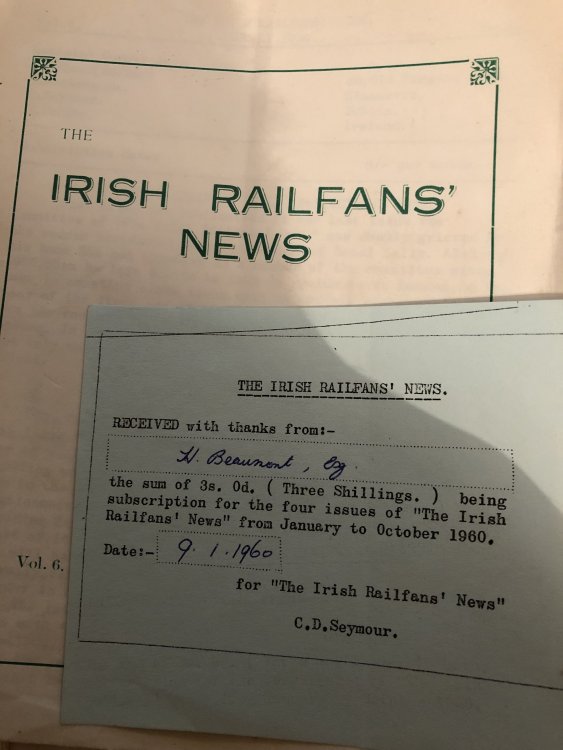-
Posts
15,859 -
Joined
-
Last visited
-
Days Won
393
Content Type
Profiles
Forums
Events
Gallery
Everything posted by jhb171achill
-
This is not meant to be an exhaustive deluge of stuff from this source, but I was prompted to delve in regard to the (justifiably) growing interest in the earlier history of A class diesels, in particular their appearance. Over time, I’ll throw in whatever other details strike me as being of possible interest to modellers. A subscription cost the equivalent of 15c in 1960......!
-
001 wasn't the only one to get this early shaded style. Several 141/181 class did too, as well as other As. It didn't last long. I'm unaware of any 121s ever having it, though I could be wrong, and most certainly no 101 did. The lighter green had variously lining and no lining; two varieties, not counting the rarer dark green. There's something niggling the back of my mind regarding the dark green. It is easy, given lighting and dirt and different camera film, to occasionally mistake the darker bus green for the post-55 railway green. I'm pretty sure there was nothing like as much dark green on "A"s as seems to be assumed; I will search for concrete information if I get a chance today.
-
Nor here! A load of children's bikes pilfered recently!
-
That is (yet another) masterpiece, David!
-
It's just a great shame that you can't photograph anything in a glass case because of the glare.....
- 33 replies
-
- model railway exhibition
- friends of cultra
-
(and 1 more)
Tagged with:
-
NCC, old photographs from April 1949
jhb171achill replied to Irishswissernie's topic in General Chat
I did a double take there as one of them looked like one of my dad’s! On comparing, his is of the same class of loco and a similar angle! My dad’s NCC photos were taken between (from memory) 1944 and 1947. -
I'm sure Boris could tell us that leaving the EU will give the UK enough to buy 62 new buses every day for every bus route from Lands End to John O'Groats!
-
That's the beast for me, then!
-
Wow! This will be one to watch!
-
One could look real, the other far away................ (I'll just get me coat......)
-
You almost think it WAS painted brown!! Yellow is a very impractical colour for railways......
-
Likewise, I don’t see it as much of interest.
-
Wow! ......"proper" cranes from the days before just about everything maintenance-wise was sheep-dipped in garish yellow! If they're for sale.....?
-
It must contain nuts!
-
You need to speak sharply to your car and discipline it.
-
Sorry to hear that, Andy. RIP. It was good to meet you at Cultra, and I thought Castlederg was easily the best layout on show that day.
-
Me too, Tony! I only decided to go on the spur of the moment late the night before! And I had to be gone by 12!
- 33 replies
-
- model railway exhibition
- friends of cultra
-
(and 1 more)
Tagged with:
-
Interesting shot! Charles has made a masterpiece of research into this little known subject.
-
The Castlederg one was truly a work of genius. So incredibly realistic, despite the smallish scale. For this type of layout, Andy has very much set the standard. I hadn't met him before either, so that was a privilege in itself. Great to see you and family again too, Patrick.
- 33 replies
-
- 1
-

-
- model railway exhibition
- friends of cultra
-
(and 1 more)
Tagged with:
-
Superb!
-
Great to meet so many of our small community at Cultra this morning. I had to meet my cousins in the afternoon (non-negotiable family event!), so I left Dublin at 8 a.m., drove to Cultra (hardly any traffic!), and spent the best part of two hours there. The drive back, punctuated by a 20 minute catnap in a layby and coffee in Applegreen, had me home by 3. Great venue, except that the 12ins - 1ft exhibits are far too close together; photography is quite impossible. Equally, all the things in glass cases like the GSWR dining car model, or Drew Donaldson's locomotives, are also impossible to photography because of the glare on the glass. You can't even see them properly. The model of the 500 class (was that one of Montgomery's?) is hidden in a corner, impossible to view properly. The curved pathway makes a journey to the loo into a major expeditionary voyage. But the layouts were great! And some of the static models were truly outstanding. Looking forward to the next one!
- 33 replies
-
- 1
-

-
- model railway exhibition
- friends of cultra
-
(and 1 more)
Tagged with:
-
For sale to fund "A" Class purchase...
jhb171achill replied to spudfan's topic in For Sale or Wanted
These models tend to be challenging. They require a great deal of maintenance and can be unpredictable. Running is often pretty smooth, but can also be off and on, rough and breakdowns are inevitable. It is always advisable to keep them well oiled. -
For sale to fund "A" Class purchase...
jhb171achill replied to spudfan's topic in For Sale or Wanted
There's always plastic surgery, Jason......! A new chassis and couplings could be fitted, and the whole thing clad in a new livery. Donald, for example, has accurate IE tan, though I'd be worried about where the Tippex stripes are. -
Didn’t ye know that, Brassnut? He also presided over the closure of many, many other lines including the entire West Cork, the Tramore line, and the remaining narrow gauge.
-
Anyone got one they’d like to sell? Looking for original 1963 livery only. Weathered or unweathered. DCC ideal, but either will do.
.png.c363cdf5c3fb7955cd92a55eb6dbbae0.png)



